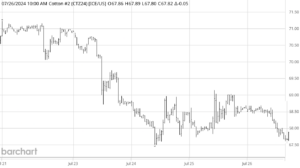For the week ending July 26, the most active Dec’24 cotton futures declined gradually, then increasingly, downshifting into a sideways sub-70 cent trading range (see chart above courtesy of Barchart.com). The December contract settled Friday down 91 points at 67.99 cents per pound. Chinese cotton prices and the A-Index followed a similar path as ICE futures.
In other ag futures markets, CBOT corn and soybean futures this week were flat-to-higher, while KC wheat futures were flat-to-lower. The U.S. dollar index followed a sideways gyration across the week. Other macro influences (i.e., GDP, inflation, and interest rate policy) continued to reflect mixed expectations, although the feeling on Friday seemed for a cooler economy that implied interest rate cuts sooner.
Cotton-specific influences this week included net negative (cancelled) U.S. export sales to signal the coming end of the 2023/24 marketing year. Next MY net sales (for 2024/25) were fairly strong, perhaps reflecting some shifting forward. The pace of 2023/24 export shipments remained below the needed weekly average pace to reach USDA’s target level of old crop exports. This week saw a widespread trough of moisture that soaked the Texas Gulf Coast region (not a good thing) and which extended further on up to the northern Delta, where it is beneficial. Across the world, the Indian monsoon rain pattern appears to be following a more normal pattern after an erratic start.
ICE cotton futures open interest gradually declined this week while futures prices settled mostly lower. This has the appearance of outright short speculative positioning, perhaps in response to firmer expectations of a 17 million bale crop. Indeed, the weekly (Tuesday July 23) snapshot of speculative positioning showed 5,399 more outright hedge fund shorts, week over week. Over the same time period there was long liquidation in the form of 1,351 fewer hedge fund longs and 102 smaller index fund net long position.
For more details and data on Old Crop and New Crop fundamentals, plus other near term influences, follow these links (or the drop-down menus above) to those sub-pages.
